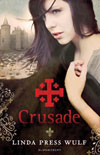History or Fiction?
Thoughts on Research: | About Crusade: | About The Night of the Burning
Using Pictures In Researching Historical Novels:
My first two books have been historical fiction and I’ve been asked a number of times how I do the research into the periods when my characters lived. I’m guessing that readers expect me to be reading volumes and volumes of history, taking notes in careful sequence. Well, eventually I do read a large number of books but not all of them are the heavy tomes that people probably imagine.
For my most recent book, about a crusade of children and youths who followed a twelve-year-old shepherd across France in a quest to reclaim the Holy Land for Christianity, I spent a good part of my research time with picture books spread out on my desk. One was part of the wonderful Eyewitness series by Dorling Kindersley, with detailed drawings of the food people ate and the clothes they wore in medieval times; another was an illustrated history of the Crusades, and a third was a fat coffee-table volume. Each of them had far more pictures than words, and they answered the questions I needed to make my characters real with details. What would the little crusaders have worn on their feet? (A number of them would have been barefoot or in shoes made out of felt.) What did they use to eat their food? (Animal horn was plentiful and easy to carve, so fathers would make a spoon for each child, a practical implement that was cleaned by licking after eating.)
For my first book, The Night of the Burning, set in Poland and South Africa after the Great War (World War I), a dream about potato latkes in my first chapter came from an unusual book of simple, child-like paintings and drawings by a woman who had lived in a Polish village not long after that period and never forgotten her mother’s kitchen.
So my advice is to make use of illustrations when you are writing a book set in the past. Look at photos of your great grandparents when you are writing a family story and notice the buckles or buttons on their wedding shoes, or the gloves or formal handbag they carried when they posed in front of Buckingham Palace, or the crumbling chimney of the family house behind them in a group portrait. Those are the kinds of details that will bring your story alive, and you can get them from pictures, not only from words.
About Crusade:
Linda will be posting information on Crusade soon.
Thanks for your interest.
About The Night of the Burning:
 The book is historical fiction, based on the meager bones of fact that my husband was told about his late mother’s childhood. That is, early in the twentieth century, she and her younger sister were left alone after a pogrom in their village of Domachevo in Poland. Their aunt died shielding them from a Cossack’s gun. Some time later, in 1921, they were chosen from among the children in a Jewish orphanage by an unusual visitor – a South African philanthropist who was haunted by the fate of hundreds of thousands of Jewish orphans in Eastern Europe after the First World War. Isaac Ochberg obtained permission from the South African government under Jan Smuts (and support from the Jewish community) to bring exactly 200 of them to the safety of South Africa, and there they were placed in the Cape Town and Johannesburg Jewish orphanages. Most of them lived relatively happily in the institutions through their growing years. However, in a new and perhaps avoidable tragedy, the two sisters were adopted into two separate – and very different — families, and their emotional relationship became very complicated.
The book is historical fiction, based on the meager bones of fact that my husband was told about his late mother’s childhood. That is, early in the twentieth century, she and her younger sister were left alone after a pogrom in their village of Domachevo in Poland. Their aunt died shielding them from a Cossack’s gun. Some time later, in 1921, they were chosen from among the children in a Jewish orphanage by an unusual visitor – a South African philanthropist who was haunted by the fate of hundreds of thousands of Jewish orphans in Eastern Europe after the First World War. Isaac Ochberg obtained permission from the South African government under Jan Smuts (and support from the Jewish community) to bring exactly 200 of them to the safety of South Africa, and there they were placed in the Cape Town and Johannesburg Jewish orphanages. Most of them lived relatively happily in the institutions through their growing years. However, in a new and perhaps avoidable tragedy, the two sisters were adopted into two separate – and very different — families, and their emotional relationship became very complicated.
There was the bare skeleton of my story. As I researched and dreamed, the flesh of it was added almost unconsciously, scenes writing themselves in random order. The hardest chapter to write was the one about the pogrom. I had read about pogroms since I was a young girl but I dreaded writing that part and left it until last. The Night of the Burning is the pivotal chapter: before it, the story is told in alternating flashbacks; after that chapter, the story catches up with Devorah. But I couldn’t write it.
Finally I went to the Jewish Library in San Francisco and sat down to read detailed accounts of pogroms for hours, until I was nauseous and shaky. Then I came home and wrote it all at once. It was hard to read it each time I had to do some editing.
(click images below for larger sizes)







